Eastern Kingsnakes are incredible snakes that rule the southern forests of North America.
They are called “Kingsnake” because of their bravery in the face of venomous snakes. They have venom immunity so can easily hunt, kill and eat venomous snakes.
This snake is easy to identify because they have glossy black scales with yellow or white chain patterns. Choosing a color pattern is one of the most enjoyable parts of adopting this species. Color is also the biggest influence on price with snakes priced from $50 to $650.
These small snakes are easy to care for, adapt well to captivity and learn to tolerate handling from a young age.
If the Eastern Kingsnake has captured your attention, read on to learn how to make the King of the forest your pet snake…
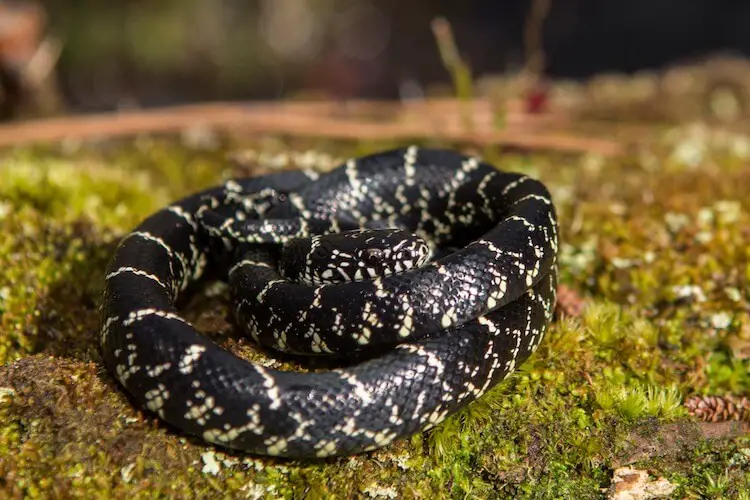
Eastern Kingsnake Overview
This species of snake is one of the most widely spread snakes in North America.
They are known to live anywhere from northern Mexico to southern New Jersey.
The Eastern King is currently listed as “least concern” by the International Union for Conservation of Nature. They are protected in some southern forests of North America due to deforestation (making them victim to predatory birds) and urbanization.
These snakes are typically a glossy black or dark brown in color with white or yellow banding across their backs. The banding meets along the sides of the snake creating a “chain” pattern.
Their scientific name, Lampropeltis getula getula, was given to them because of their unique chain pattern and appearance:
- Lampos means “radiant”
- Pelta means “tiny shields”
- Getula references the Getulians of Morocco who used chain patterns in their clothing and artwork.
Despite being known for their feisty temperament as babies, this snake is one of the best for beginners because they very quickly tame with handling and are happy to eat varied foods.
What We Like About Kingsnakes
Pros
- Famous for eating venomous snakes because of their venom immunity.
- With frequent handling as a baby they tame easily and quickly.
- This snake is a consistent eaters and adapts very well to frozen-thawed prey for their diet
- They are hardy snakes that do not require advanced husbandry.
Cons
- This snake needs specific heat requirements in their enclosure.
- They must live alone and cannot be co-habitated.
- If they are handled incorrectly or too frequently they will spray musk or bite because they feel threatened.
Species Appearance
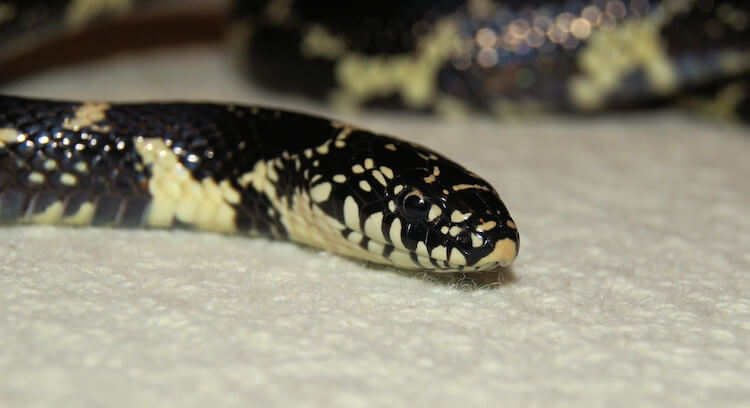
There are nine recognized subspecies of Kingsnakes.
The Eastern variety is similar in appearance to many of the nine recognized subspecies in their family. They have glossy black scales with yellow or white chain patterns.
Genomic studies suggest that five of these subspecies should be recognized as their own species:
- Eastern lineage (Eastern Kingsnake)
- Mississippi lineage (Black Kingsnake)
- Central lineage (Speckled Kingsnake)
- Desert lineage (Desert Kingsnake)
- Western lineage (California Kingsnake)
Eastern Kingsnake Size
Kingsnakes hatch from eggs at between 8-12 inches long. Typically, they will reach 2ft long by the end of their first year and be fully grown by 5 years measuring between 3-5 feet long.
Compared to some other North American snakes (e.g. the Bull Snake, Indigo, and even Rat Snake), this snake will appear small.
These snakes tend to be long and slender with short, stout heads.
There are no significant visual differences between males and females. Probing is the only reliable method of sexing.
Color Variations and Markings
Eastern Kingsnakes are like many of the nine subspecies in their scientific family.
They have a dark brown to black body and any kind of variation of yellowish-white speckles and bands along their bodies.
Speckled, Apalachicola, and Black species all have some variation of light speckles on darker scales.
California, Florida, and Eastern are predominantly banded with the chain-like pattern. California Kings, however, tend to have thinner and more white than yellow bands.
The only truly unique subspecies are the light brown Brooks Kingsnake and the jet black Mexican Black. Mexican Black Kings are jet black without any pattern. The Brooks is a speckled pattern, but are light brown in color.
Enclosure & Set Up

Eastern Kingsnakes are always terrestrial (i.e. do not live in trees like other reptiles) but are often found near water. They can be found in pinelands, hardwood forests, swamps, wetlands, farmlands, and even suburban areas.
Despite their widespread geographic-range, these snakes are very secretive.
You will normally find this species hiding in stumps and burrows or under logs, boards, tins, and bushes.
Providing natural décor and hiding places in their enclosure will allow them to perform their typical behaviors. Your snake should display exploring, digging, basking, and hunting behaviors.
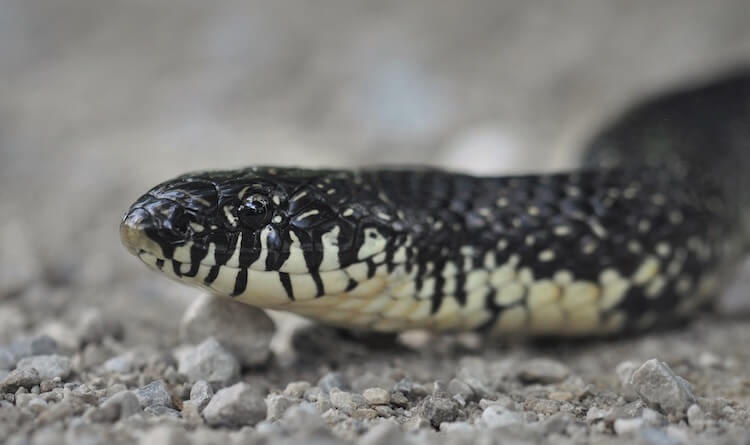
Eastern Kingsnakes typically grow 3-5ft in length, though some exceed this. As this snake grows, they will require different sized enclosures:
- Babies should be housed in 10-gallon vivariums (or similarly sized plastic tubs).
- At 24 inches long, juvenile Eastern Kingsnakes should be upgraded to a 20-gallon long.
- If your snake grows over 4ft in length, move to a 40-gallon tank.
Remember, this species is terrestrial, so focus on floor space, not height!
- Tank Type: Glass vivarium.
- Tank Size: 20-gallon.
- Lighting: 75-100 watt basking bulb.
- Substrate: Topsoil.
Sticks, plants, leaf litter, hay, bark, or straw should be used to provide environmental enrichment.
Make sure you sanitize any décor found outdoors with 10% bleach spray and leave for 3-5 days in the sun to help kill any pathogens. Be sure to add areas where the snake can curl up and hide.
A large water dish for soaking and drinking should be provided in their enclosure.
Finally, place a secure lid on the enclosure to prevent escape. A screen top with clamps for a terrarium or a lock-top plastic lid with breathing vents will suffice.
All Kingsnakes self-thermoregulate, so they need a temperature gradient in their enclosure:
- Eastern Kingsnakes need a cool side with a temperature of 75°F-80°F. This can be heated with an under-tank heater or low wattage ceramic heat emitter. Both devices need a thermostat and thermometer.
- The hot side of their enclosure should be 85°F-90°F. The hottest place should be directly underneath a 75-100 watt basking lamp. A basking spot lamp is best because it can serve as a day-night cycle.
Never use heat rocks or heat pads inside the tank. Snakes will sit on them and suffer severe burns from the constant high heat.
Using substrates that can be easily changed is a good idea for babies.
That’s why babies are typically housed on newspaper or paper towels.
Although they can also live on paper too, adults prefer 2-3 inches of substrate for burrowing and digging.
The best substrate choices for adults are: coconut fiber, organic topsoil (without perlite), bark chips, or aspen shavings.
You should avoid pine or cedar shavings. The oils and dust from these types of woods can cause eye irritation and respiratory issues for your snake.
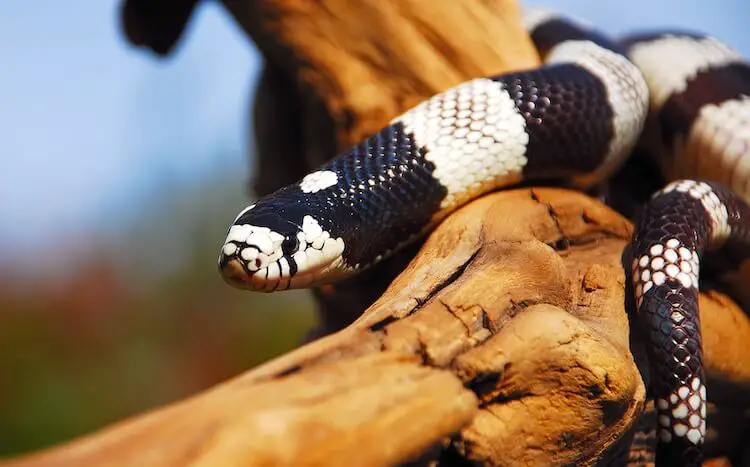
Tank Cleaning & Misting
Cleaning your snake’s tank is simple, but imperative for maintaining good health.
Every few days, you should spot clean the tank to remove any feces, shed skin and uneaten food.
Substrate should be changed every 3-4 weeks. If you don’t spot clean frequently this will need to be every 2 weeks.
Changing the substrate keeps fungal or bacterial growth from infesting the soil. This helps to prevent issues like scale rot and respiratory infections.
During a substrate change, while the tank is empty, consider scrubbing all décor and using a 10% bleach solution to sanitize the inside of the tank.
Make sure the tank is dry before replacing the substrate.
Eastern Kingsnake Care

What Do Eastern Kingsnakes Eat?
Eastern Kingsnakes are opportunistic hunters.
In the wild, they are known to feed on lizards, frogs, salamanders, small mammals, birds, and even other snakes.
This snake can expand their jaws to eat prey that is nearly as large as their body size. Their constrictor abilities also make them experts at eating snakes that are similar in size.
In captivity, you should feed frozen-thawed prey. This will help to avoid prey-induced injuries during feeding.
These snakes adapt quickly to frozen-thawed prey.
To thaw prey:
- Place frozen prey in the refrigerator overnight (or in cold water for 30-60 minutes).
- Once thawed, place the bagged rodent in a warm water bath to raise the temperature (do not use the microwave defroster; it will just breed bacteria).
As your snake ages, their feeding size should increase, and frequency should decrease.
Babies should be fed once every 5-7 days, juveniles every 7-10 days, and adults every 10-14 days.
It can be hard to find frozen salamanders, so it is best to feed frozen mice, rats, and chicks. Prey should never be wider than the widest part of the snake. This will help to lower the risk of regurgitation.
If you decide to feed live prey, it must be removed immediately if uneaten. You should also examine your snake’s eyes and face for injuries after each meal.
Finally, provide your snake with a water bowl as they will drink from it.
Common Health Issues
Just like any animal, snakes can suffer from health issues and carry diseases.
With consistent and correct husbandry, these hardy snakes can live to be anywhere from 15-25 years old. Careful husbandry and attentiveness to your snake are important in making sure they can live that long.
Some common diseases include:
- Mouth rot
- Internal parasites
- Mites
- Scale rot
- Inclusion Body Disease
- Respiratory infections
- Stress-induced anorexia
Mouth rot is often a secondary infection from a low immune system or an untreated mouth injury. If the swelling and discharge are noticed early enough, it can usually be treated with antibiotics by a veterinarian.
Scale rot is normally due to overly moist or dirty substrate allowing bacteria growth. It can usually be slowed by cleaning the tank and allowing the snake to heal on clean paper towels for several weeks.
Mites can usually be treated with over the counter products like Prevent-a-Mite, though a vet should be consulted to find the appropriate treatment plan for you.
As with any new reptile, you should pay close attention and make note of regular bowel movements, eating routines, and activity levels.
Any abnormality may signal the need to contact a veterinarian.
Signs They Are Healthy
- Hunting/foraging behaviors.
- Eating regularly.
- Sheds are intact with eyecaps.
Sickness Symptoms
- Self-soaking for several hours at a time.
- Refusing prey.
- Stuck shed on eyes or body.
Typical Behavior
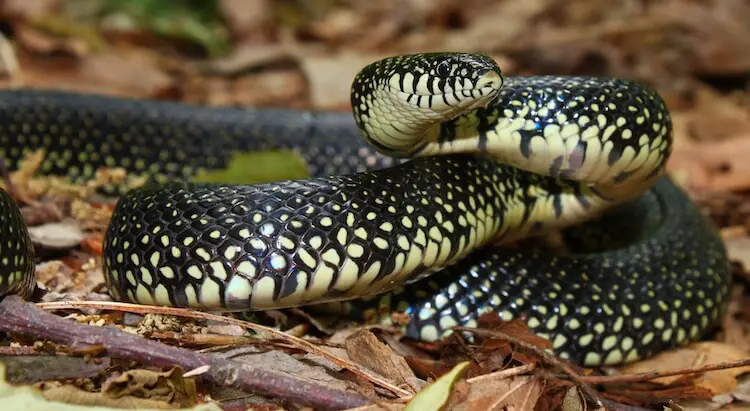
In the wild, the Eastern Kingsnake is a feisty snake. They have mastered the arts of fear, intimidation, flight, hiding, and self-defense.
When threatened, this species will show quick, jerky movements.
Their jerky movement helps to startle any predator that is approaching. If that doesn’t work and they can’t hide, they will often shake their tail like a rattlesnake.
These snakes are solitary in the wild when not mating.
In captivity, these snakes calm with age. Frequent, slow handling helps them become accustomed to human touch.
Your snake will enjoy exploring, digging and basking. So you should also provide plenty of hiding places and a deep substrate to help encourage these natural behaviors.
Overall, they are very docile and tame as juveniles and adults. Babies’ behavior may need to be tolerated, but their bite is nothing to fear.
Is An Eastern Kingsnake Venomous?
No. They are completely nonvenomous, but biting can be stressful for an inexperienced owner. If picked up, a wild Kingsnake will likely expel a foul smelling musk and possibly bite. Though harmless, it can be unpleasant!
They seldom bite, but are known to constrict around and chew on whatever they see as prey.
Handling Advice and Tips
Any reptile can carry Salmonella. While harmless to your snake, it can infect you and lead to terrible intestinal side effects.
Sanitation before and after handling is essential. Washing your hands with soap and warm water is recommended.
You should handle your snake frequently. This will help to ensure they don’t become aggressive as adults.
As babies, you can normally reach in slowly and just pick them up. If your snake is a little jumpy, you can use a small snake hook to let them know that they are being handled.
If handled frequently, your snake will grow up to be calm and docile. However, it is important to note, each snake has an individual personality and may not adapt to handling as easily as others.
Baby Eastern Kingsnake
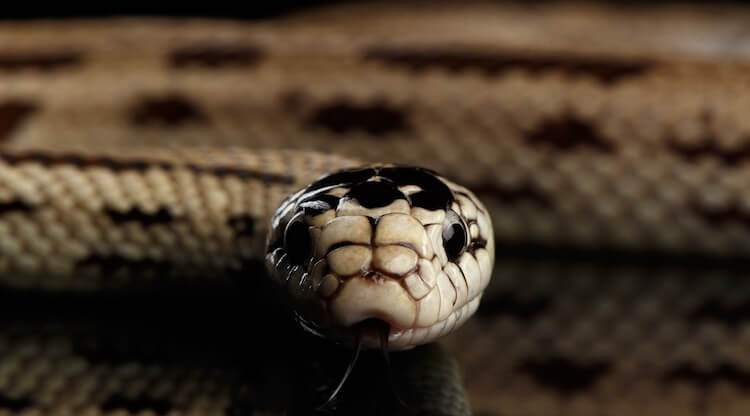
Babies are typically identical to adults in their appearance (e.g. color and patterns), behavior, and diet (besides eating smaller prey). Immediately after hatching, they are independent.
Males will often court females during Spring. They will bite the female’s neck and then twist their tail around hers and begin writhing.
Females lay 1-2 clutches in the Summer with 10-24 eggs in each.
After 60-75 days, the snakes will hatch and are ready to begin hunting and finding a home.
How Much Does An Eastern Kingsnake Cost?
You can find Kingsnakes on sale for anywhere from $50-$650. Color and pattern are the biggest influence on price.
Morphs have been bred to exaggerate their desired appearance; the rarer the morph, the more expensive the snake.
Buyer’s Guide
This species is not endangered, however, you should still check local and state laws before adoption. Many states have laws governing native species, so you may have to choose a subspecies.
You should buy your snake from a reputable breeder.
Always look for an active, alert snake to buy!
Healthy snakes will be active, exploratory, or trying to find a place to hide to feel safe. If a snake seems limp or lethargic, has a wobbling head, or seems to be “star-gazing,” that snake is likely sick.
Eastern Kingsnake Facts
| Common Name | Chain Kingsnake, Common Kingsnake |
|---|---|
| Scientific Name | Lampropeltis getula getula |
| Price | $50 to $650 |
| Size | 3-5 feet long |
| Lifespan | 15 to 25 years |
| Diet | Small mammals, lizards, amphibians, birds, and snakes |
| Tank Size | Minimum 20-gallon, 40-gallon preferred |
| Humidity & Temperature | Ambient Temperature: 75°F-85°F Basking Temperature: 85°F-90°F Humidity: 35%-60% |
| Popular Alternatives | Corn Snake, Rat Snake, and Scarlet Kingsnake |
Summary
Eastern Kingsnakes are medium-sized, beautiful snakes that take well to captivity.
They are hardy animals that eat well and exercise frequently when given the space. Their high-activity level means that any owner must provide an enriching enclosure.
If you like the Eastern Kingsnake, there are eight other subspecies to choose from that have nearly identical care requirements and size. Other species of similar snakes include the:
- Corn Snake
- Milk Snake
- Blue Racer
Though temperature requirements can be tricky, this snake is easy to care for, making them one of the most popular beginner snakes.
Ready to crown a new King in your home? Let us know in the comments below!


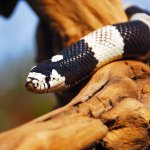
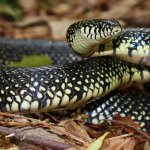
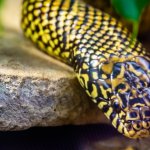
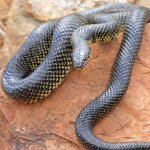
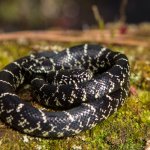
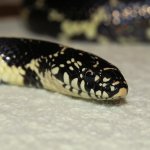
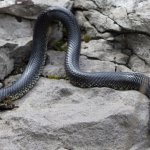
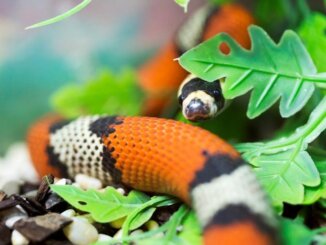
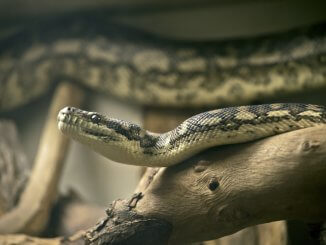
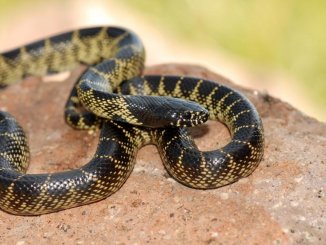

Great info. Years ago I had a California King, he was an easy keeper and ate very well. Also raised a corn snake from a tiny baby. He grew to about 2 feet. My wife names him Pop!